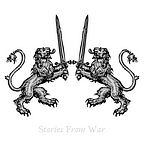Blutfahne — The Nazi Blood Flag
O n the evening of 8 November 1923, inspired by Mustafa Kemal Ataturk and Benito Mussolini’s March on Rome, a politician named Adolf Hitler, along with a large number of paramilitary troops of the Sturmabteilung, a militant outfit of the Nationalsozialistische Deutsche Arbeiterpartei, or the Nazi Party, surrounded a beer hall in Munich. Inside the hall, State Commissioner Gustav Ritter von Kahr was making a speech in front of an audience of more than 3,000 people. Adolf Hitler, once inside, fired a shot in the air, stood up on a chair, and announced:
The national revolution has broken out! The hall is surrounded by six hundred men. Nobody is allowed to leave.
He then claimed that the current Bavarian government had been deposed and went on to announce the formation of a new one under famed WW1 General Ludendorff. By mid-morning the next day, the plotters of the coup had decided to march on the streets of the city with 2000 men. As the men reached the Bavarian Defense Ministry, they were met with 130 soldiers. The two groups exchanged fire, leading to the deaths of 4 State Police Officers and 16 Nazis. It was at this time that the Nazi flag, which was being carried by the marching NSDAP members, got soaked in the blood of a dead SA man, becoming one of the Nazi Party’s most sacred relics. Hitler fled the scene, but was later arrested and tried for high treason. This was a turning point in his political career, and paved his way to becoming one of the world’s most infamous dictators.
The Blutfahne was the company flag of the 5th Munich SA, and after the failed Putsch, was hidden by the SA men, and was presented to Hitler when he was released from prison. It was mounted on a black pole with a special unique wreath flag top. Nearby, a dedication plate was laid, listing the names of those killed in the Munich Putsch. According to Nazi philosophy, the Blutfahne had been made sacrosanct because it the blood of a martyr for the Nazi cause had fallen on it.
The flag was ceremonially bestowed upon the then head of the infamous Schutzstaffel, or the SS, Joseph Berchtold, at the Second Nazi Party Congress in 1926. Thereafter, the flag obtained a sanctified status, and became one of the most prized relics of the Nazi Party. At all party rallies and meetings, it was carried by SS-Sturmbannführer Jakob Grimminger, who was appointed as the official standard bearer. Here’s what we know about Jakob Grimminger, according to Brian Davis’ book Flags of the Third Reich:
Jakob Grimminger…was born on 25 April 1892. He served in the German Army during the Great War with sufficient distinction to be awarded the Imperial Iron Cross, 2nd Class. After the war [he] joined the Nazi Party and was an early member of the SS. He participated in the Munich Putsch of 9 November 1923. Later he was appointed to be the official bearer of the Blutfahne, and attained the rank of SS-Standartenführer; he was also appointed a Councillor for the City of Munich. He survived the Second World War and the period of post-war Allied occupation, after which, it is believed, he managed to obtain work as a street sweeper. Grimminger died in Munich in obscurity and poverty on 28 January 1969, at the age of seventy-seven.
At the annual Nuremberg Rallies, Hitler would use the Blutfahne to sanctify other Nazi flags, by holding the former and touching the other banners. It was also used to seal the blood oath of newly-conscripted SS men.
When not in use, the flag was kept in the Nazi HQ in Munich, called the Brown House, with an SS guard of honour. It was last seen at the induction ceremony of the Volksstrum, a militia composed of civilians established by Nazi Germany in the last months of World War 2, on 18 October 1944. After this, there is no recorded display of the Blutfahne. While the current whereabouts of the flag are unknown, a large number of historians speculate that it was destroyed when the Allied forces bombed the Brown House in 1945, and fragments of it where taken by US forces as souvenirs.
For a summarized version of this article, that is easy to share, check out the post on our Instagram page!
